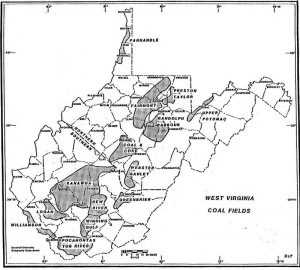
The Flat Top / Pocahontas Coal Field is the name used to describe a coal-producing section of West Virginia that includes the following counties, in whole or in part: Mercer and McDowell counties. The term Flat Top draws on the field's location near the southern end of Flat Top Mountain.
The chief producing seam of the Pocahontas field is known as the No. 3. The No. 4 and No. 6 have also been worked to a lesser extent. Some mines in the field worked the upper seams of the Pocahontas group, which is situated geologically, in the Pottsville series.
The Pocahontas No. 3 is an excellent steam coal. Some claimed it to be the world's best, calling it the only successful rival of the Cardiff coal of Wales. The coals of the Pocahontas Coal Field were known as "smokeless coals." In combustion, they give off little smoke and a small amount of ash as residue, and deliver a high heat value, in ready response to a draft, either natural or forced. The Pocahontas coals would coke quickly, usually under ten minutes in hand-fired plants.
Development of the Flat Top - Pocahontas Coal Field
Between 1880 and 1892, Major Jed Hotchkiss, of Stanton, Virginia, promoted the potential of the Pocahontas Coal Field and was instrumental in the development of the Flattop Land Association which lead to the building of the Norfolk & Western Railway into the field. Through the columns of The Virginias, a geologic journal of which he was editor, Hotchkiss persistently advocated the merits of the Pocahontas field and urged its development.
The first shipment of coal from the Pocahontas Coal Field in Virginia was made in 1883, from a mine in Pocahontas, Tazewell County, Virginia. Following the completion of an extension of the Norfolk & Western Railway, the first shipment of coal from the Flat Top-Pocahontas Coal Field in West Virginia was made by William Beury and John Cooper, from the Beury-Cooper mines located near present-day Bramwell, WV on November 10, 1884. The Freeman-Jones mine began shipping coal on January 4, 1885, followed by William Booth and Company, on January 15, of the same year.




